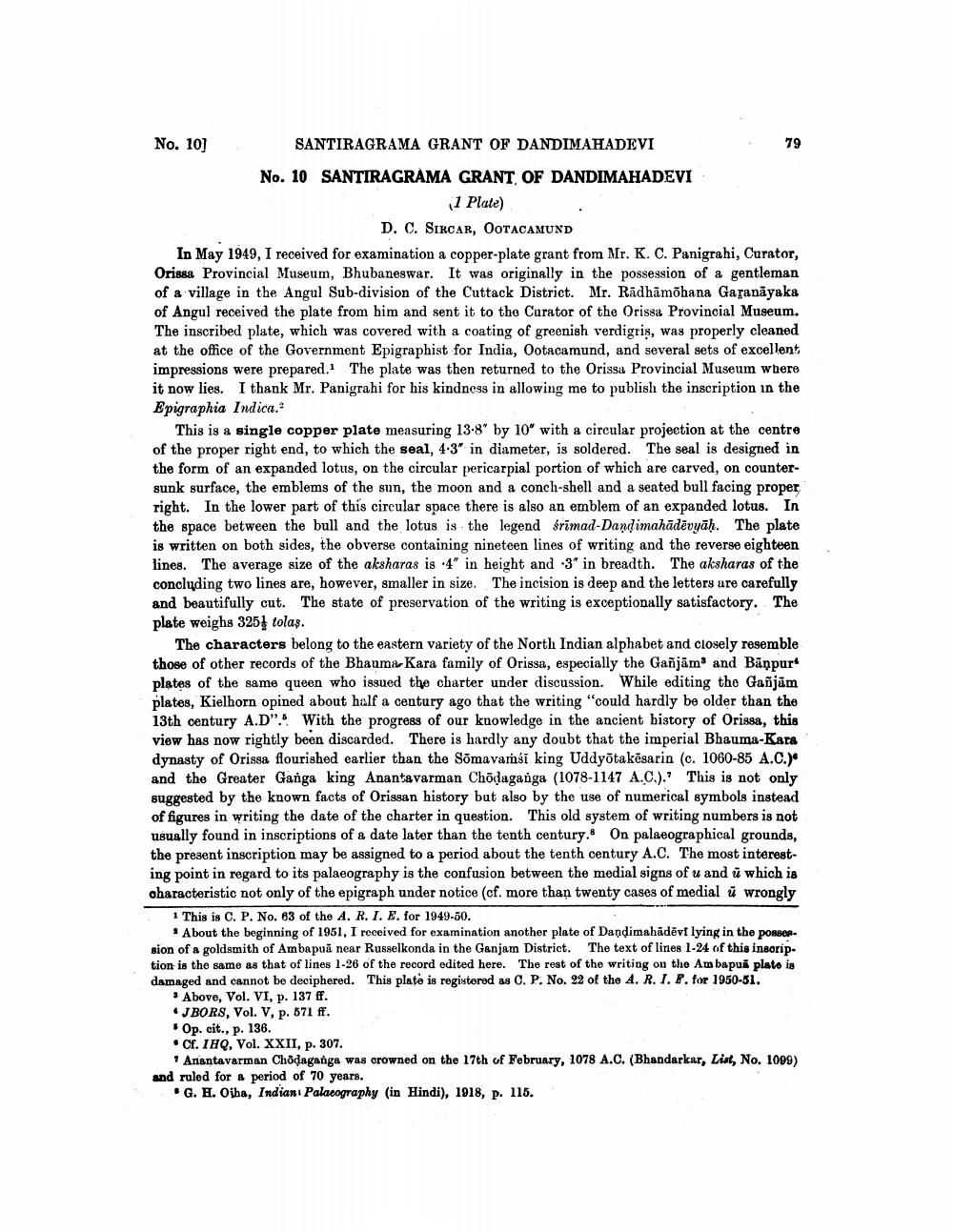________________
No. 10) SANTIRAGRAMA GRANT OF DANDIMAHADEVI
79 No. 10 SANTIRAGRAMA GRANT OF DANDIMAHADEVI
1 Plate)
D. C. SIKCAR, OOTACAMUND In May 1949, I received for examination a copper-plate grant from Mr. K. C. Panigrahi, Curator, Orissa Provincial Museum, Bhubaneswar. It was originally in the possession of a gentleman of a village in the Angul Sub-division of the Cuttack District. Mr. Rādhāmōhana Gapanāyaka of Angul received the plate from him and sent it to the Curator of the Orissa Provincial Museum. The inscribed plate, which was covered with a coating of greenish verdigris, was properly cleaned at the office of the Government Epigraphist for India, Ootacamund, and several sets of excellent impressions were prepared. The plate was then returned to the Orissa Provincial Museum where it now lies. I thank Mr. Panigrahi for his kindness in allowing me to publish the inscription in the Epigraphia Indica.
This is a single copper plate measuring 13.8" by 10" with a circular projection at the centre of the proper right end, to which the seal, 4.3" in diameter, is soldered. The seal is designed in the form of an expanded lotus, on the circular pericarpial portion of which are carved, on countersunk surface, the emblems of the sun, the moon and a conch-shell and a seated bull facing proper right. In the lower part of this circular space there is also an emblem of an expanded lotus. In the space between the bull and the lotus is the legend Srimad-Dandimahādēvyāḥ. The plate is written on both sides, the obverse containing nineteen lines of writing and the reverse eighteen lines. The average size of the aksharas is .4" in height and 3* in breadth. The aksharas of the concluding two lines are, however, smaller in size. The incision is deep and the letters are carefully and beautifully cut. The state of preservation of the writing is exceptionally satisfactory. The plate weighs 3251 tolas.
The characters belong to the eastern variety of the North Indian alphabet and closely resemble those of other records of the Bhaumar Kara family of Orissa, especially the Gañjām and Bänpur plates of the same queen who issued the charter under discussion. While editing the Gañjām plates, Kielhorn opined about half a century ago that the writing "could hardly be older than the 13th century A.D". With the progress of our knowledge in the ancient history of Orissa, this view has now rightly been discarded. There is hardly any doubt that the imperial Bhauma-Kara dynasty of Orissa flourished carlier than the Sõmavamsi king Uddyōtakēsarin (c. 1060-85 A.C.) and the Greater Ganga king Anantavarman Chodaganga (1078-1147 A.C.).? This is not only suggested by the known facts of Orissan history but also by the use of numerical symbols instead of figures in writing the date of the charter in question. This old system of writing numbers is not usually found in inscriptions of a date later than the tenth century. On palaeographical grounds, the present inscription may be assigned to a period about the tenth century A.C. The most interesting point in regard to its palaeography is the confusion between the medial signs of u and ů which is characteristic not only of the epigraph under notice (cf. more than twenty cases of medial û wrongly
1 This is C. P. No. 63 of the A. R. I. E. for 1949-50.
1 About the beginning of 1951, I received for examination another plate of Dandimahādēvi lying in the possession of a goldsmith of Ambapuã near Russelkonda in the Ganjam District. The text of lines 1-24 of this insoription is the same as that of lines 1-26 of the record edited here. The rest of the writing ou the Ambapua plato is damaged and cannot be deciphered. This plate is registered as C. P. No. 22 of the A. R.I.. for 1950-51.
. Above, Vol. VI, p. 137 ff. • J BORS, Vol. V, p. 571 ff. * Op. cit., p. 136. • Cf. IHQ, Vol. XXII, p. 307.
* Anantavarman Chödaganga was crowned on the 17th of February, 1078 A.C. (Bhandarkar, List, No. 1099) and ruled for a period of 70 years.
.G. H. Oiha, Indian Palacography (in Hindi), 1918, p. 115.




